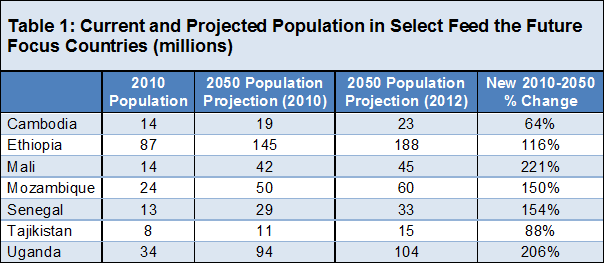-
Faster-Than-Expected Population Growth in Many “Feed the Future” Countries
August 1, 2013 By Kathleen Mogelgaard
Cambodia to grow by nearly one-third by 2050; Kenya to more than double; Mali to swell to three times its current size. These were the population projections available when Feed the Future, President Obama’s global hunger and food security initiative, was beginning implementation in 19 focus countries around the globe in 2010.
The over-arching goals of Feed the Future are to reduce both the prevalence of poverty and the prevalence of stunted children by 20 percent. The cross-government initiative incorporates a broad range of interventions, from developing new seed varieties to training smallholder farmers in new management techniques and strengthening delivery systems for maternal and child health and nutrition services.
But revised population projections, released last month by the UN Population Division, show that the populations in these countries could grow even faster than previously anticipated. In seven Feed the Future focus countries – Cambodia, Ethiopia, Mali, Mozambique, Senegal, Tajikistan, and Uganda – population is projected to grow at least 20 percent more between 2010 and 2050 than UN demographers projected just two years ago (see Table 1). In sum, there are now projected to be 274 million more people added to these countries by the middle of the century.
How might a strategy for food security change when all of a sudden the demographic future looks different? In countries that already are grappling with food security challenges, a greater-than-anticipated boost in population is likely to amplify the struggle.
Women’s Empowerment, Access to Reproductive Health Key
On a global level, the new projections forecast a world population of 9.6 billion in 2050, 250 million greater than demographers projected in the last revision two years ago. This update takes into account new information about demographic trends that overturns prior assumptions made about birth rates and death rates. While there are a handful of countries whose populations are now projected to be not quite as large in 2050, the overall upward revision is due in large part to the fact that the fertility is not falling as quickly as previously expected, particularly in many sub-Saharan African countries.
The factors that underlie slower-than-anticipated fertility declines are numerous and varied. In immediate and practical terms, access to quality reproductive health and family planning information and services is required for families to avoid unintended pregnancy and actualize their fertility preferences. Globally, it is estimated that more than 220 million women would like to avoid pregnancy but lack family planning.

In the seven Feed the Future countries listed in Table 1, national Demographic and Health Surveys indicate high proportions of women have this unmet need for family planning: 34 percent of women in Uganda, 30 percent of women in Senegal, 28 percent of women in Mali, and 26 percent of women in Ethiopia. Many see meeting this need for family planning as a basic human right, and its importance for women and child health, community health, and overall development is reflected in the Millennium Development Goals and ongoing discussions about the what will replace them.
The ability to determine the number, timing, and spacing of children is also closely linked to women’s empowerment, a factor recognized by Feed the Future as a critical component of strengthening prospects for food security. Feed the Future is piloting the Women’s Empowerment in Agriculture Index for performance monitoring and impact evaluation. In addition to assessing gender parity within households, the index measures the extent to which women are empowered across five key domains: production, resources, income, leadership, and time. Understanding women’s empowerment in these areas can help to inform interventions that can strengthen women’s empowerment in ways that support food security outcomes. Clearly, a woman’s ability to plan her pregnancies is a relevant factor in each of these domains.
More Evidence of the Integration Imperative
The new population projections serve as a call to redouble efforts in promoting women’s empowerment and expanding access to reproductive health and family planning services. The stories we can tell are not all gloomy ones: In Malawi, for example, where population, land, and climate dynamics threaten food security, the new population projections show a lower expected figure for 2050, reflecting faster-than-anticipated drops in fertility. As Elizabeth Leahy Madsen points out, the emphasis placed on girls’ education, access to family planning, and women’s economic empowerment by President Joyce Banda has likely contributed to these changes.
The significant population increases projected in countries that are priorities for food security investment point toward opportunities for comprehensive approaches that can promote multiple, reinforcing development outcomes. As we have seen with other development initiatives that bring together interventions in population, reproductive health, and natural resource management, such integration can result in synergies that deliver results that are stronger than single sector interventions. As efforts to promote women’s empowerment expand within Feed the Future programs, the inclusion of reproductive health and family planning services is a logical – and needed – step forward.
Kathleen Mogelgaard is a writer and analyst on population and the environment, and a consultant for the Environmental Change and Security Program.
Sources: Feed the Future, Guttmacher Institute, MEASURE DHS, UN, UN Population Division.
Photo Credit: A USAID-supported farm in northern Uganda, courtesy of USAID.
Topics: Africa, agriculture, Asia, Cambodia, demography, development, Ethiopia, family planning, featured, food security, gender, global health, Malawi, Mali, Mozambique, population, Senegal, Tajikistan, Uganda, UN, USAID
 A Publication of the Stimson Center.
A Publication of the Stimson Center.




